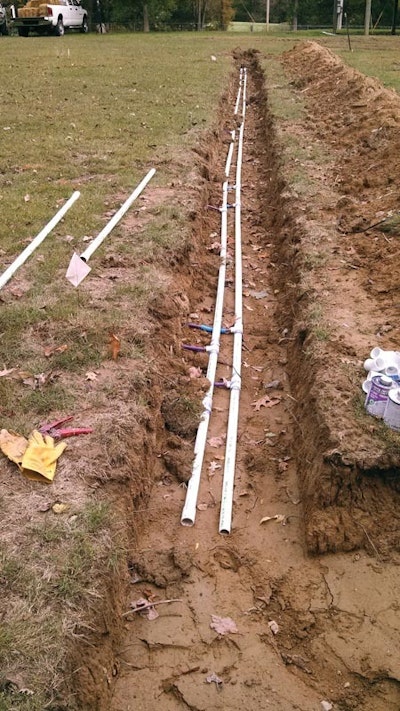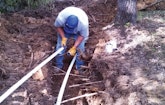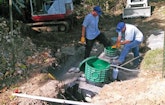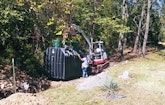
Interested in Systems/ATUs?
Get Systems/ATUs articles, news and videos right in your inbox! Sign up now.
Systems/ATUs + Get AlertsGravestones in the cemetery next to Log Providence Missionary Baptist Church testify to the congregation’s longevity in central Missouri. Some stones are not the carefully shaped and carved blocks of granite or marble typical today. These gravestones are real stones — rough rocks picked from the ground and dated in the 1830s. All this history was no help to the congregation when it confronted a modern wastewater problem. The church may be old, but it is not wealthy and needed creative help to solve the problem within the budget it had. It found that help in installer Kyle Shern and the generosity of firms in the onsite industry. After sorting out issues and dealing with weather, the new system was completed in October 2014.
Wrong-way water
The septic system at Log Providence was not failing. Based on the appearance of the concrete tank he found, Shern, owner of Bio-Gard Inc. in Columbia, Missouri, dated the system to the 1970s. Where the water went created the problem. The ABS discharge pipe from the tank emerged from a slope behind the church, ran along the surface of the ground for about 25 feet and dropped effluent into a sinkhole. The sinkhole had also become a garbage depository. Shern found an old mailbox, a toilet, a refrigerator and other refuse there.
Near the church is the Three Creeks State Park, and as part of an investigation the state found that discharge pipe. Sinkholes in Missouri are underlaid with karst, and fissures in the rock structure channel wastewater quickly through the ground. The state found wastewater from the church was running into some of the many caves that draw tourists to Missouri. In addition there are two endangered species in the caves, a type of salamander and a type of bat. Those environmental concerns spelled the end of the old septic system. The state ordered the discharge pipe to be capped immediately, and the septic tank became a holding tank until the old system could be replaced.
There was no effect on the church’s water supply or surrounding wells, Shern says. The water table in Missouri runs deep, about 800 feet, and the expense of drilling that far has given rise to cooperatives that drill wells and lay mains to supply nearby properties.
Leaders of Log Providence had a dripline system designed as a replacement, but from somewhere they received an inaccurate cost estimate. “And that’s literally all they could afford, and they’d already borrowed the money on top of it,” Shern says. Church leaders approached him with their problem, and Shern went to work to make the project affordable.
First he talked to the people at the Boone County Health Department. They’re good to work with, Shern says, and they allowed him to reduce the size of the dripfield to the minimum needed. Should the church expand in the future and generate an increased wastewater flow, permits will require the dripfield to be expanded.
Next Shern called a few people he knows: Curtis Cluckey from Infiltrator Systems, Darrin Meyer from Clarus Environmental, and Shelly Wybensinger and Chris Mandich from Jet Inc. He explained the church’s financial situation and asked for a little help. The companies gave a lot. Jet donated one of its ATU systems. Infiltrator donated a tank. Clarus provided a control panel. Shern’s crew went to work.
The new system
From the church, wastewater flows west through a 4-inch pipe for about 40 feet toward the old concrete septic tank. The old tank was left in place. Should the church expand in the future, this tank could become a dosing tank for the ATU. Shern’s workers intercepted this and added an extension at about a 45-degree angle to take wastewater another 50 feet to the new Jet ATU. This is an 850-gallon J-800PLT three-chamber plastic tank. The first chamber is for primary settling. Next is an aeration tank with a fixed film medium that Shern says he finds ideal for systems where large flows alternate with long periods of inactivity. The third chamber is a clarifier with a sloped bottom. Material that flocculates sinks by gravity along the sloped bottom and moves through an opening back into the aeration tank for further processing.
From the Jet tank, water flows by gravity about 6 feet to a 1,500-gallon Infiltrator poly tank that doses the dripfield. A Goulds pump and about 150 feet of 1 1/4-inch pipe take water to the dripfield. The field is about 125 feet by 64 feet and is composed of 16 lines of Netafim with a combined length of about 2,000 feet. The Clarus panel runs the system. It provides six doses over a period of 18 hours with 125 gallons per dose.
Driplines were installed at a depth of 10 to 12 inches. Freezing is not an issue in this area, and the dripfield is higher than the dosing tank so any excess water drains back to the tank.
Two of Shern’s employees, Ben Maness and Kevin Rouse, installed the system in about four days. They used a Takeuchi TL130 skid-steer and a Takeuchi TB145 excavator for the job. To lay the Netafim lines they used a Case Maxi-Sneaker vibratory plow.
Installing
At 1,500 gallons, the dosing tank may seem overly large for this use, but Shern says its size accommodates a factor designers may overlook in church projects: baptisms. As a Baptist church, Log Providence has an 800-gallon font for full-body immersion. This is clean, clear water, but when the font is drained it still means 800 gallons of water hit the system. The big Infiltrator tank gives this volume a place to stop and settle before it is sent on to
the dripfield.
For this part of Missouri, dripfields are ideal because the soil may not drain well, Shern says. Even in the biologically active zone just a few inches below grade, soils can still have a significant fraction of clay. Tests at the Log Providence site found about 13 percent clay in the silty loam that occupies the first 8 inches of soil. By 30 inches down clay is about 42 percent of
the soil.
When tanks were in place, Shern’s crew backfilled with half-inch-minus aggregate. It has helpful characteristics. The stones are small enough so they don’t have sharp points and edges that damage plastic tanks, Shern says. Because local aggregate is limestone, this size of stone also includes a fair amount of limestone dust. Those fine particles fill voids nicely, and when it rains they bind together forming an almost concrete-like layer around tanks. This helps hold tanks in the ground and sheds water that otherwise would tend to accumulate around a tank.
Installation went smoothly. Shern’s process is to assemble as much as possible in the shop. Technicians put pumps and floats in place, make electrical connections and run conduit. Control panels are mounted on decorative PVC fence posts — which look better, Shern says — and laid on top of tanks. When a crew reaches the job site and has the holes and trenches ready, they drop the tanks in place, set the control panel post upright, make pipe and power connections, and backfill. It’s a quick and efficient system, Shern says. Indoor assembly is a great project for rainy days, and technicians do not have to move a lot of material to and from job sites. Everything is at hand in the shop.
Working next to the church provided its own challenge because of the old graves. Trenches and holes for the new system came within a few feet of four of them, Shern says, but fortunately there was just enough room between the graves and the woods around the sinkhole to maneuver tanks into place and lay pipes and conduit.
Project completion
Bio-Gard will perform maintenance on the system, too. Missouri law does not require maintenance contracts for ATUs, but Shern says he has found it better for his customers and his company if Bio-Gard takes care of the systems it has installed.
The only real problem was weather. “We had a lot of rain, and then the winter was just horrendous down here. We didn’t work for three months,” Shern says. Then homebuilding, the company’s primary source of income, began picking up, and the demands of other jobs delayed work at Log Providence.
But now the church job is done. After two years, a good deal of creative thinking and simple generosity, this old congregation can remain settled in its historic home.









